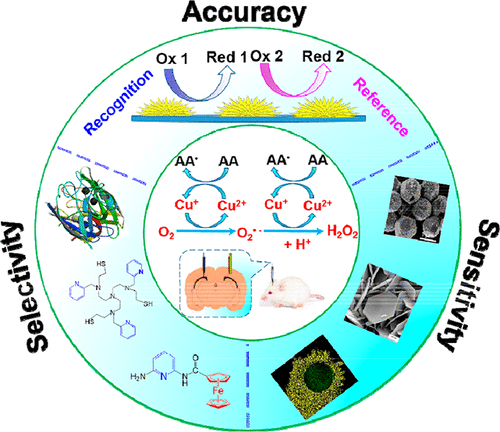当前位置:
X-MOL 学术
›
Acc. Chem. Res.
›
论文详情
Our official English website, www.x-mol.net, welcomes your
feedback! (Note: you will need to create a separate account there.)
Designing Recognition Molecules and Tailoring Functional Surfaces for In Vivo Monitoring of Small Molecules in the Brain
Accounts of Chemical Research ( IF 16.4 ) Pub Date : 2018-02-27 00:00:00 , DOI: 10.1021/acs.accounts.7b00543 Limin Zhang 1 , Yang Tian 1
Accounts of Chemical Research ( IF 16.4 ) Pub Date : 2018-02-27 00:00:00 , DOI: 10.1021/acs.accounts.7b00543 Limin Zhang 1 , Yang Tian 1
Affiliation

|
The in vivo analysis of chemical signals in brain extracellular fluid (ECF) using implanted electrochemical biosensors is a vital way to study brain functions and brain activity mapping. This approach offers excellent spatial (10–200 μm) and temporal (approximately second) resolution and the major advantage of long-term stability. By implantation of a microelectrode in a specific brain region, changes in the concentration of a variety of ECF chemical species can be monitored through applying a suitable electrical signal and, typically, recording the resulting Faradaic current. However, the high performance requirements for in vivo biosensors greatly limit our understanding of the roles that biomolecules play in the brain. Since a large number of biological species, including reactive oxygen species (ROS), metal ions, amino acids, and proteins, coexist in the brain and interact with each other, developing in vivo biosensors with high selectivity is a great challenge. Meanwhile, it is difficult to quantitatively determine target molecules in the brain because of the variation in the distinct environments for monitoring biomolecules in vitro and in vivo. Thus, there are large errors in the quantification of concentrations in the brain using calibration curves obtained in artificial cerebrospinal fluid (aCSF). More importantly, to gain a full understanding of the physiological and pathological processes in the brain, the development of novel approaches for the simultaneous determination of multiple species in vivo is urgently needed.
中文翻译:

设计识别分子并定制功能表面,以体内监测大脑中的小分子
使用植入的电化学生物传感器对脑细胞外液(ECF)中的化学信号进行体内分析是研究脑功能和脑活动图谱的重要方法。这种方法具有出色的空间分辨率(10–200μm)和时间分辨率(约秒),并且具有长期稳定性的主要优点。通过在特定的大脑区域植入微电极,可以通过施加合适的电信号并通常记录所产生的法拉第电流来监视各种ECF化学物质浓度的变化。但是,体内生物传感器的高性能要求极大地限制了我们对生物分子在大脑中所扮演的角色的了解。由于大量的生物物种,包括活性氧(ROS),金属离子,氨基酸和蛋白质,共存于大脑中并相互影响,开发具有高选择性的体内生物传感器是一项巨大的挑战。同时,由于在体外和体内监测生物分子的不同环境中的变化,难以定量确定脑中的靶分子。因此,使用在人工脑脊髓液(aCSF)中获得的校准曲线对大脑中的浓度进行定量分析存在很大误差。更重要的是,为了全面了解大脑的生理和病理过程,迫切需要开发同时测定体内多种物种的新方法。由于在体外和体内监测生物分子的不同环境中存在差异,因此难以定量确定大脑中的目标分子。因此,使用在人工脑脊髓液(aCSF)中获得的校准曲线对大脑中的浓度进行定量分析存在很大误差。更重要的是,为了全面了解大脑的生理和病理过程,迫切需要开发同时测定体内多种物种的新方法。由于在体外和体内监测生物分子的不同环境中存在差异,因此难以定量确定大脑中的目标分子。因此,使用在人工脑脊髓液(aCSF)中获得的校准曲线对大脑中的浓度进行定量分析存在很大误差。更重要的是,为了全面了解大脑的生理和病理过程,迫切需要开发同时测定体内多种物种的新方法。使用在人工脑脊髓液(aCSF)中获得的校准曲线来量化大脑中的浓度时,存在很大的误差。更重要的是,为了全面了解大脑的生理和病理过程,迫切需要开发同时测定体内多种物种的新方法。使用在人工脑脊髓液(aCSF)中获得的校准曲线来量化大脑中的浓度时,存在很大的误差。更重要的是,为了全面了解大脑的生理和病理过程,迫切需要开发同时测定体内多种物种的新方法。
更新日期:2018-02-27
中文翻译:

设计识别分子并定制功能表面,以体内监测大脑中的小分子
使用植入的电化学生物传感器对脑细胞外液(ECF)中的化学信号进行体内分析是研究脑功能和脑活动图谱的重要方法。这种方法具有出色的空间分辨率(10–200μm)和时间分辨率(约秒),并且具有长期稳定性的主要优点。通过在特定的大脑区域植入微电极,可以通过施加合适的电信号并通常记录所产生的法拉第电流来监视各种ECF化学物质浓度的变化。但是,体内生物传感器的高性能要求极大地限制了我们对生物分子在大脑中所扮演的角色的了解。由于大量的生物物种,包括活性氧(ROS),金属离子,氨基酸和蛋白质,共存于大脑中并相互影响,开发具有高选择性的体内生物传感器是一项巨大的挑战。同时,由于在体外和体内监测生物分子的不同环境中的变化,难以定量确定脑中的靶分子。因此,使用在人工脑脊髓液(aCSF)中获得的校准曲线对大脑中的浓度进行定量分析存在很大误差。更重要的是,为了全面了解大脑的生理和病理过程,迫切需要开发同时测定体内多种物种的新方法。由于在体外和体内监测生物分子的不同环境中存在差异,因此难以定量确定大脑中的目标分子。因此,使用在人工脑脊髓液(aCSF)中获得的校准曲线对大脑中的浓度进行定量分析存在很大误差。更重要的是,为了全面了解大脑的生理和病理过程,迫切需要开发同时测定体内多种物种的新方法。由于在体外和体内监测生物分子的不同环境中存在差异,因此难以定量确定大脑中的目标分子。因此,使用在人工脑脊髓液(aCSF)中获得的校准曲线对大脑中的浓度进行定量分析存在很大误差。更重要的是,为了全面了解大脑的生理和病理过程,迫切需要开发同时测定体内多种物种的新方法。使用在人工脑脊髓液(aCSF)中获得的校准曲线来量化大脑中的浓度时,存在很大的误差。更重要的是,为了全面了解大脑的生理和病理过程,迫切需要开发同时测定体内多种物种的新方法。使用在人工脑脊髓液(aCSF)中获得的校准曲线来量化大脑中的浓度时,存在很大的误差。更重要的是,为了全面了解大脑的生理和病理过程,迫切需要开发同时测定体内多种物种的新方法。











































 京公网安备 11010802027423号
京公网安备 11010802027423号